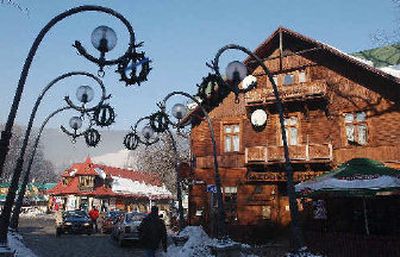Winter destination

ZAKOPANE, Poland – You could say Zakopaneis blessed.
After all, it was the late Pope John Paul II’s favorite recreation spot. He spent a lot of time there as a young priest – skiing the Tatra mountains and hiking the Podhale hills – and he returned later as he climbed the ranks in the Catholic Church, then finally as pope.
When he was a cardinal, someone mentioned it might be inappropriate for a man of his position to ski. His reply was that it was only “unbecoming for a cardinal to ski badly.”
No matter how well – or badly – you ski, there’s a slope to suit you around Zakopane.
Some of the most popular are located at Kasprowy Wierch, which can be reached by cable car or lift, and Gubalowka, which is accessible by tram and T-bars. But there are many others.
And even though there’s a lot of snow in the winter, there’s also artificial snow-making to supplement when necessary.
The winter sports are so good in this area that Zakopane was a finalist for the 2006 Olympics.
During the summer you can bike, raft, climb, hike, paraglide or just stroll through the mountain meadows. There are also several folk, art and musical festivals.
Zakopane is about 60 miles south of Krakow near the Slovakian border. It’s nestled up against the Tatras, the highest alpine range in this region of Europe.
Because of its location, it has become a major winter destination. Its year-round population swells during tourist season.
Many of those people come for reasons other than the winter sports. For me, it was the shopping. And I can tell you, I didn’t leave empty-handed. Neither did my daughter, the shoe queen, who walked away with a great pair of red leather knee-high boots for around $40. (A U.S. dollar is worth about three Polish zlotys.)
The town center is a charming blend of old world meets new. The architecture is a mix of carved wood villas with traditional high-sloped roofs and newer European-style stone storefronts.
We were lucky enough to be there while the Christmas decorations were still up and there was plenty of snow on the ground. It added even more old-world charm to the scene.
Homes were decorated with holiday lights and religious icons, many of which were built right into the side of the houses. Parents pulled high-sided wooden sleds along the streets; inside were pink-cheeked babies nested in fleecy blankets, caps, snowsuits and mittens.
Look on the corner and you’ll see a T-shirt vendor and someone selling fuzzy puppets on a stick. Look the other way and there’s an old woman in a patterned headscarf selling cheese and pickles.
You can catch a horse-drawn wagon ride, mingle with the street performers, duck into any number of really good restaurants, museums or churches, stroll over a quaint wooden bridge, or sign up for a more modern diversion – a bungee jump.
The main shopping street is Krupowki, where you can find quality European fashions, bookstores, gift shops, household items, glassware, jewelry, ski clothes and warm outerwear – and, of course, shoes and boots.
And while I did pick up some souvenir items on Krupowki, I found a better selection on one of the side streets where vendors set up rows of wooden stalls. They were full of sheepskin and leather goods, fur, glassware, rugs, slippers at around $4 and local rough wool sweaters for about $10.
You can also find a huge selection of carved wooden boxes, religious icons, chess sets, nutcrackers and kitchen utensils.
My favorites were the starched and embroidered table and dresser cloths, napkins, and doilies. I bought several of them, thinking they’d make wonderful gifts. Unfortunately for my friends, I fell in love with them, and now they’re all over my house.
This market also had a variety of cheeses and farm products, military items and several litters of St. Bernard puppies – cute, but wouldn’t fit in my suitcase, especially since it was stuffed full of linens.
The food in Zakopane is very good, except for an odd concoction I bought on the street. It turned out to be a piece of bread soaked with thick, hot bacon fat – definitely an acquired taste.
Other than that you can expect a good selection of sausage, pork, bread, cheese, potatoes, other hearty vegetables and beer. Many restaurants feature servers dressed in highly decorative native costumes and musicians playing a local form of Polish highlander music called “muzyka goralska.”
Oh, and one more thing about Zakopane: It has a good environmental reputation. A large part of it is heated by geothermal energy coming from hot water underground.
Local officials are proud of their recent efforts to keep the area’s water, air, land and views pristine.